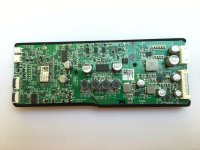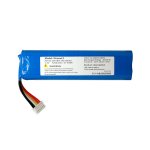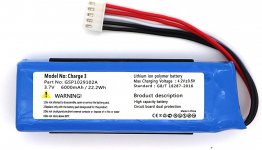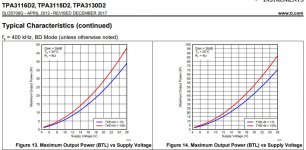Hi all,
Speaker building is my hobby and I am in that area for around two years.
I'm building portable Bluetooth speakers based on TPA3116 and a power supply this is an important thing.
I have high current batteries 18650. One battery can give 5A max.
What is my purpose:
1. Use only two 18650 batteries.
2. The battery connection scheme can be parallel or serial, it depends on the step-up module.
3. Output of power in watts from this amplifier must be clear 15W per channel without clipping.
4. I will use speakers with impedance 4 Om.
5. Output voltage from batteries must be stable, that means when battery discharge, input voltage on amplifier must be without change.
Based on the datasheet of TPA3116 for 15W per channel for 4 Om I need around 12V and 3A.
I need to use the dc-dc step-up module to cover all my goals.
Parallel battery connection scheme:
Two batteries give 4.2V max and 10A max = 42W. I used the dc-dc step-up module based on XL6009 and as a result, I couldn’t get a clear sound with 15W. Moreover, the voltage after the step-up module went down on high volume.
Serial battery connection scheme:
Two batteries give 8.4V max and 5A max = 42W. I’ve got the same result as with a parallel connection with XL6009. Moreover, I used the dc-dc step-up module based on U024V and I didn’t get any success too.
And in the case with a dc-dc step-up module that can give a negative effect on the sound.
Questions:
Could you please recommend to me the best dc-dc step-up module for speakers?
Could you please share with me your experience with power supply and portable speakers?
What is battery connection scheme better for all my goals?
Speaker building is my hobby and I am in that area for around two years.
I'm building portable Bluetooth speakers based on TPA3116 and a power supply this is an important thing.
I have high current batteries 18650. One battery can give 5A max.
What is my purpose:
1. Use only two 18650 batteries.
2. The battery connection scheme can be parallel or serial, it depends on the step-up module.
3. Output of power in watts from this amplifier must be clear 15W per channel without clipping.
4. I will use speakers with impedance 4 Om.
5. Output voltage from batteries must be stable, that means when battery discharge, input voltage on amplifier must be without change.
Based on the datasheet of TPA3116 for 15W per channel for 4 Om I need around 12V and 3A.
I need to use the dc-dc step-up module to cover all my goals.
Parallel battery connection scheme:
Two batteries give 4.2V max and 10A max = 42W. I used the dc-dc step-up module based on XL6009 and as a result, I couldn’t get a clear sound with 15W. Moreover, the voltage after the step-up module went down on high volume.
Serial battery connection scheme:
Two batteries give 8.4V max and 5A max = 42W. I’ve got the same result as with a parallel connection with XL6009. Moreover, I used the dc-dc step-up module based on U024V and I didn’t get any success too.
And in the case with a dc-dc step-up module that can give a negative effect on the sound.
Questions:
Could you please recommend to me the best dc-dc step-up module for speakers?
Could you please share with me your experience with power supply and portable speakers?
What is battery connection scheme better for all my goals?
Use 3 cells. If that's too big use 18500. Presto, 100% converter efficiency.
What about this point?
5. Output voltage from batteries must be stable, that means when battery discharge, input voltage on amplifier must be without change.
If I use 3 cells I will have a problem with output power, during discharge, the output power will decrease, am I right?
Yes true but for the penalty of a regulator you should probably be sure there is something intolerable about discharge voltage and impedance curves of these modern batteries in this application. Maybe you need four cells. Maybe it really does need a boost converter.
Last edited:
The power dissipation of all of these little regulators is limited, thus as you increase the current the maximum input-output voltage reduces. With a fixed input voltage, the output voltage will reduce.
You need both a decent battery and good headroom on the regulator. For 15W into 4 ohm per channel we are looking at 4A output current total. For 3x step-up voltage the current at the input will be 3x the output, so 12A.
This is without considering efficiency losses and with zero headroom.
And finally, the regulator needs to be able to handle ((Vout-Vin) x Iout) on a continuous basis. The XL6009 and a couple batteries can't do that.
You can try paralleling 3x XL6009 and use a small fan. You'll need to set the output voltages to the closest decimal point separately then connect them together.
You need both a decent battery and good headroom on the regulator. For 15W into 4 ohm per channel we are looking at 4A output current total. For 3x step-up voltage the current at the input will be 3x the output, so 12A.
This is without considering efficiency losses and with zero headroom.
And finally, the regulator needs to be able to handle ((Vout-Vin) x Iout) on a continuous basis. The XL6009 and a couple batteries can't do that.
You can try paralleling 3x XL6009 and use a small fan. You'll need to set the output voltages to the closest decimal point separately then connect them together.
Again, if there aren't any 16 volt capacitors on the amplifier B+, then four cells could be an easy winner.
With a limited input voltage you can achieve a constant max output over varying battery voltage using 3 or 4 cells.
Yielding best efficiency without a stepup-converter with its own set of inherent problems. And later on perhaps you will remove this input voltage limiter when you have learned that the difference in output level over battery discharge is not worth the effort of regulating.😉
Yielding best efficiency without a stepup-converter with its own set of inherent problems. And later on perhaps you will remove this input voltage limiter when you have learned that the difference in output level over battery discharge is not worth the effort of regulating.😉
What about this point?
5. Output voltage from batteries must be stable, that means when battery discharge, input voltage on amplifier must be without change....
Why?
A good audio amp has high PSRR.
The only time the power supply should matter is when the amplifier is over-driven. Don't do that.
Yes true but for the penalty of a regulator you should probably be sure there is something intolerable about discharge voltage and impedance curves of these modern batteries in this application. Maybe you need four cells. Maybe it really does need a boost converter.
Yes, I can understand that the batteries must be able to withstand high currents. As an option I have 26650 batteries and they can give up to 50A max.
The power dissipation of all of these little regulators is limited, thus as you increase the current the maximum input-output voltage reduces. With a fixed input voltage, the output voltage will reduce.
You need both a decent battery and good headroom on the regulator. For 15W into 4 ohm per channel we are looking at 4A output current total. For 3x step-up voltage the current at the input will be 3x the output, so 12A.
This is without considering efficiency losses and with zero headroom.
And finally, the regulator needs to be able to handle ((Vout-Vin) x Iout) on a continuous basis. The XL6009 and a couple of batteries can't do that.
You can try paralleling 3x XL6009 and use a small fan. You'll need to set the output voltages to the closest decimal point separately then connect them together.
As I mentioned above, I have quite good batteries two types 18650 and 26650. And yes I lose battery capacity with the step-up module (around 30%). Could you please give me more details about ((Vout-Vin) x Iout)? How I can do that? And thank you for idea about 3xXL6009 I will test it and let you know.
With a limited input voltage you can achieve a constant max output over varying battery voltage using 3 or 4 cells.
Yielding best efficiency without a stepup-converter with its own set of inherent problems. And later on perhaps you will remove this input voltage limiter when you have learned that the difference in output level over battery discharge is not worth the effort of regulating.😉
You are right, much better to use 3 or 4 cells than a dc-dc step-up module. But one of the huge advantages of the dc-dc step-up is weight, size and price. This is a portable speaker, and I know that it has many small problems during building than for example bookshelf speakers. This is challenging for me.
I would like to share with you the results of my research.
I found speaker from JBL with similar characteristics, JBL Charge 3.
Output power 10W per channel or 20W total.
Battery has 3.7V and capacity 6000 mAh.
Amplifier TPA3118


Based on datasheet for 10W clear sound need 10V for 4 Om. That means they use step-up module.
Another example JBL Extreme 2.
Output power 20W per channel or 40W total.
Battery has 7.2V and capacity 5200 mAh.
Amplifier TPA3116 (as I could find)

Based on datasheet for 20W clear sound per channel need 14V for 4 Om. That means they use step-up module too.

How does it work on those speakers?
I found speaker from JBL with similar characteristics, JBL Charge 3.
Output power 10W per channel or 20W total.
Battery has 3.7V and capacity 6000 mAh.
Amplifier TPA3118
Based on datasheet for 10W clear sound need 10V for 4 Om. That means they use step-up module.
Another example JBL Extreme 2.
Output power 20W per channel or 40W total.
Battery has 7.2V and capacity 5200 mAh.
Amplifier TPA3116 (as I could find)
Based on datasheet for 20W clear sound per channel need 14V for 4 Om. That means they use step-up module too.
How does it work on those speakers?
Attachments
Vin in Voltage input (battery voltage)
Vout is amplifier supply voltage
Iout is current draw for a given output into a given load impedance.
In your case, using a 4V battery and a 12V output at 4A (for 20W total) is 32W power dissipation in the regulator. Assume 40W after considering losses @85% efficiency.
As to the JBL speakers, unless they're tested we won't know what the numbers actually are. In any case, they seem to be using a much higher quality booster design on what seems to be at least a 4-layer board, instead of a dubiously designed single chip on a sloppy PCB. So in any case their result will be better than what you can achieve. Things change quite a lot when you go from 85% to 95% efficiency.
Vout is amplifier supply voltage
Iout is current draw for a given output into a given load impedance.
In your case, using a 4V battery and a 12V output at 4A (for 20W total) is 32W power dissipation in the regulator. Assume 40W after considering losses @85% efficiency.
As to the JBL speakers, unless they're tested we won't know what the numbers actually are. In any case, they seem to be using a much higher quality booster design on what seems to be at least a 4-layer board, instead of a dubiously designed single chip on a sloppy PCB. So in any case their result will be better than what you can achieve. Things change quite a lot when you go from 85% to 95% efficiency.
- Home
- Amplifiers
- Power Supplies
- Power Supplies for TPA3116 (18650)



